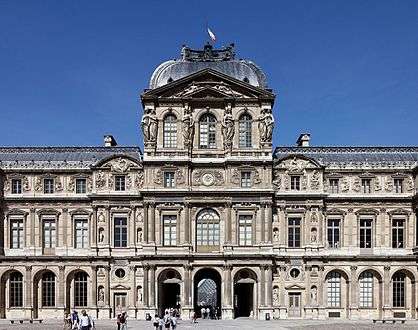Pavillon de l’Horloge
Coordinates: 48°51′38.21″N 2°20′15.70″E / 48.8606139°N 2.3376944°E

The Pavillon de l’Horloge (French, "Clock Pavilion"), also known as the Pavillon Sully, is a prominent pavilion located in the center of the west wing of the Cour Carrée (Square Court) of the Palais du Louvre in Paris. The two names Pavillon de l'Horloge and Pavillon Sully are now often reserved for the central pavilion's eastern and western faces, respectively.[1]
Pavillon de l'Horloge
The pavilion was built just north of the older Lescot Wing between 1624 and about 1645. The famous structure, with its square-domed roof, was designed by architect Jacques Lemercier (1585–1654).[2] The name comes from a clock (French: horloge) later incorporated into its elevation.
Pavillon Sully
The structure become known as the Pavillon Sully (after Maximilien de Béthune, duc de Sully) early in the 19th century. Its western facade was completely remodeled by Hector Lefuel in the 1850s during the Second Empire.
 Lemercier's western facade from the former rue Fromenteau, late 18th century
Lemercier's western facade from the former rue Fromenteau, late 18th century Western facade of the Pavillon Sully, designed by Hector Lefuel
Western facade of the Pavillon Sully, designed by Hector Lefuel
Notes
Bibliography
- Bautier, Geneviève Bresc (1995). The Louvre: An Architectural History. New York: The Vendome Press. ISBN 9780865659636.
- Blunt, Anthony (1960). "Two Unpublished Drawings by Lemercier for the Pavillon de l'Horloge", The Burlington Magazine, vol. 102, no. 691 (October), pp. 446–448. JSTOR 873224
- Blunt, Anthony; Beresford, Richard (1999). Art and architecture in France, 1500-1700. New Haven Connecticut: Yale University Press. ISBN 0-300-07748-3.
- Gady, Alexandre (2005). Jacques Lemercier, architecte et ingénieur du Roi. Paris: Maison des sciences de l'homme. ISBN 9782735110421.
External links


- (in French) Structurae.de page on the Palais du Louvre's building history